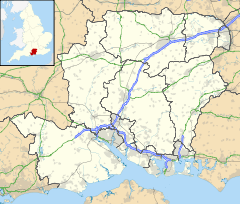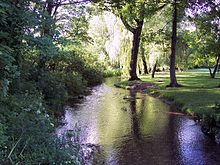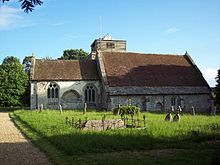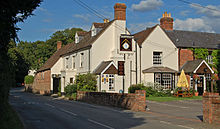- Damerham
-
Coordinates: 50°56′38″N 1°51′13″W / 50.94378°N 1.85373°W
Damerham 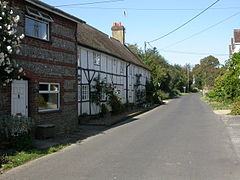
Damerham
 Damerham shown within Hampshire
Damerham shown within HampshirePopulation 519 [1] OS grid reference SU103160 District New Forest Shire county Hampshire Region South East Country England Sovereign state United Kingdom Post town FORDINGBRIDGE Postcode district SP6 Dialling code 01725 Police Hampshire Fire Hampshire Ambulance South Central EU Parliament South East England UK Parliament New Forest West List of places: UK • England • Hampshire Damerham is a village and civil parish in Hampshire, England, located near to Fordingbridge. As well as being the location of notable Neolithic and Bronze Age barrows, Damerham was an important Anglo-Saxon manor mentioned in the will of Alfred the Great. By the time of the Domesday Book of 1086, Damerham was a major settlement in the possession of Glastonbury Abbey. Today Damerham is a rural village on the River Allen.
Contents
Overview
Situated north west of Fordingbridge and close to the Dorset border, Damerham is located on the River Allen.[2] Damerham contains a mixture of cottages, with a riverside mill and a Norman church.[2] Settled since Saxon times, Damerham is said to be the birthplace of Æthelflæd, wife of Edmund I.[2]
Adam of Damerham (13th century), the author of Historia de Rebus gestis Glastoniensibus, was a native of Damerham.[3] Damerham was once in Wiltshire, but was transferred in 1895 to Hampshire.[3]
The village gave its name to a Ham class minesweeper, HMS Damerham.
History
Damerham is the site of a prehistoric complex including two 6,000-year-old tombs representing some of the earliest monuments built in Britain.[4] It was discovered by a team led by Dr. Helen Wickstead, a Kingston University archaeologist. These were previously undiscovered Neolithic tombs known as long barrows.[4][5]
Another earthwork, Soldiers Ring, situated on a crest in an area of Celtic fields, is thought to be a Romano-British cattle enclosure.[6]
Damerham was an ancient demesne of the Saxon kings and was mentioned in the will of Alfred the Great, who desired that his men of Damerham should in future be free.[3] In 940–6 Edmund I granted a hundred mansae at Damerham with Martin and Pentridge to his queen, Æthelflæd.[3] Damerham may have been the birthplace of Æthelflæd.[2] Æthelflæd bequeathed Damerham to Glastonbury Abbey when she died in the late 10th century.[7]
In the time of the Domesday Book, 1086, Damerham was a large settlement of 80 households.[8] Glastonbury Abbey still held the manor, which remained with the abbey until the Dissolution of the Monasteries.[3] It then passed to the Crown, and in 1540 Henry VIII leased part of the demesne land and certain farms belonging to the manor for 21 years to Richard Snell - these premises were in 1608 granted to Robert Cecil, 1st Earl of Salisbury, and remained with his descendants.[3] In 1544 Henry VIII granted the manor of Damerham to his sixth wife, Catherine Parr, but it passed back to the Crown on her death in 1548.[3] In 1575 Elizabeth I granted it to the Bishop of Salisbury, and, except for the temporary sale by Parliament to William Lytton in 1649, it remained in the possession of successive bishops until 1863.[3]
Another important manor was the manor of Little Damerham which was owned by Glastonbury Abbey.[3] Glastonbury Abbey also held lands in the manors of Hyde and Stapleham.[3] Some of these lands were also held by Cranborne Priory, and Tewkesbury Abbey, to which Cranborne Priory was a cell.[3] The hide at Lopshill (Lopushale) is mentioned as within the boundaries of the manor of Damerham in 940–6; it is now Lopshill Farm, in the south of the parish.[3]
The Domesday Book records four mills at Damerham.[8] One was given to Geoffrey Fitz-Ellis by John, Abbot of Glastonbury (1274–90).[3] In 1326 Henry Dotenel released to the Abbot of Glastonbury all his claim in a water-mill called Weremulle in Damerham.[3] In the survey of the manor taken in 1518 a water-mill called Lytellmyle is mentioned.[3] This mill probably stood near Littlemill Bridge at North End, but it has now disappeared.[3] In 1608 "all the water-mills of Damerham" were granted to Robert Earl of Salisbury.[3] The only mill now in existence in the parish is Damerham Mill in the village on the River Allen.[3]
Damerham Park is mentioned in 1226–7 and in 1283, and at the latter date it contained deer.[3] In 1518 the park, which contained 125 acres of wood, was divided into three coppices, Edmundshay, Middle Coppis, and Drakenorth Coppis.[3] It was apparently disparked before 1540.[3]
The church of Saint George dates from the Norman period.[2] The earliest parts are the lower part of the tower and the north aisle (12th century).[3] In the 13th century the chancel was seemingly rebuilt and a south aisle added to the nave.[3] The tower was nearly rebuilt around this time. The 12th-century north aisle and transept were probably pulled down in the 15th century and the existing aisle substituted.[3] The church has some rare features, including scratch dials and a relief of Saint George.[2]
In 1830 the manor-house (West Park House) was attacked by the rioters against the introduction of machinery (Swing Riots) and several people were captured and sent to Winchester.[3] One quarter of the village burned down in the "Great Fire" of 1863, but the damage was soon repaired owing to the exertions of the vicar William Owen.[9][3]
References
- ^ "2001 Census Neighbourhood Statistics - Civil Parishes in the New Forest". www.neighbourhood.statistics.gov.uk. http://www.neighbourhood.statistics.gov.uk/dissemination/viewFullDataset.do;jsessionid=ac1f930c30d592f3f49c79b64fa1b9b4aa5a4f597a47?instanceSelection=03070&productId=779&$ph=60_61&datasetInstanceId=3070&startColumn=1&numberOfColumns=4&containerAreaId=790410. Retrieved 2011-07-08.
- ^ a b c d e f Hampshire Treasures - Damerham, page 73
- ^ a b c d e f g h i j k l m n o p q r s t u v w x y z Victoria County History, (1912), A History of the County of Hampshire: Volume 5, Pages 586-591
- ^ a b Neolithic Age: Prehistoric Complex Including Two 6,000-year-old Tombs Discovered In Britain
- ^ Huge Pre-Stonehenge Complex Found via "Crop Circles" James Owen, National Geographic News, June 15, 2009
- ^ Hampshire Treasures - Damerham, page 76
- ^ Will of Æthelflæd, at www.anglo-saxons.net
- ^ a b Domesday Map - Damerham
- ^ History, www.damerham.net
External links
- Damerham Community Web Site
- Damerham Parish Council
- The Damerham Archaeology Project An educational organisation that gives members of the public, school children and students the opportunity to visit and/or participate in archaeology.
Towns, villages and hamlets in the New Forest District of Hampshire, England 
Allum Green | Applemore | Ashlett | Ashley | Ashurst | Bartley | Barton on Sea | Bashley | Beaulieu | Bisterne | Blashford | Blissford | Bolderwood | Boldre | Bramshaw | Bransgore | Breamore | Brockenhurst | Brook | Brookheath | Bucklers Hard | Burgate | Burley | Bull Hill | Cadnam | Calshot | Colbury | Copythorne | Crow | Damerham | Denny Lodge | Dibden | Dibden Purlieu | Downton | East Boldre | East End | East Hill | East Martin | East Mills | Emery Down | Ellingham | Everton | Exbury | Fawley | Fordingbridge | Fritham | Frogham | Furze Hill | Godshill | Gorley Lynch | Hale | Hale Park | Hale Purlieu | Hangersley | Harbridge | Hightown | Highwood | Hordle | Hungerford | Hyde | Hythe | Ibsley | Keyhaven | Lepe | Linbrook | Linford | Linwood | Lopshill | Lower Daggons | Lymington | Lyndhurst | Marchwood | Martin | Milford on Sea | Minstead | Mockbeggar | Netley Marsh | New Milton | Norley Wood | North Gorley | Ossemsley | Pennington | Picket Hill | Picket Post | Pilley | Portmore | Poulner | Ringwood | Rockbourne | Rockford | Sandford | Sandleheath | Shobley | Sopley | South Baddesley | South Gorley | Stuckton | Sway | Tinkers Cross | Tiptoe | Totton and Eling | Walhampton | Whitsbury | Whitsbury Common | Whitsbury Cross | Woodgreen | Woodlands
Categories:- New Forest
- Villages in Hampshire
Wikimedia Foundation. 2010.

